"Drag and Drop" DnD Complex Trap - The Arcane Conflux
Posted by Annabelle Collins on
Hey all! I am starting a “drag and drop” series once a month where I will be making complex traps, side-quests, encounters and more for you to drag and drop into your own D&D or roleplaying games!

My idea is to create a compendium of interesting, fun and free DnD content that you can adapt and use however you like. They will add a bit of fun to your games without you having to do a whole bunch of prep yourself! :D
Todays complex trap is suitable for parties of level 7-10 that I like to call the Arcane Conflux.
I've included a detailed description of how it works, including counter measures that your players might take, and how you might scale it for parties of different levels.
How the Trap Works
Trap Description

The Arcane Conflux is a magically trapped room, most likely set by a medium-powerful spell caster. It is great for dropping in to guard the entrance to a Mage’s secret chamber or to protect access to a magical item.
Because of the complexity and arcane power of the trap I would suggest placing it in a Wizard’s stronghold or similar. You're not likely to find this in a kobolds den. ... Or maybe you are in your world, what do I know? ;)
The trap activates in several phases, and changes damage types each round to keep your players on their toes.
The trap is decently difficult, so I'd give your players a decent reward from overcoming it. Something like a valuable item(s) or crucial information would be great.
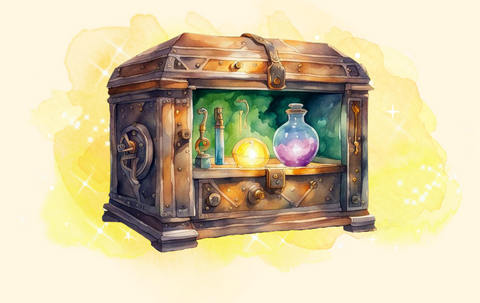
Trigger
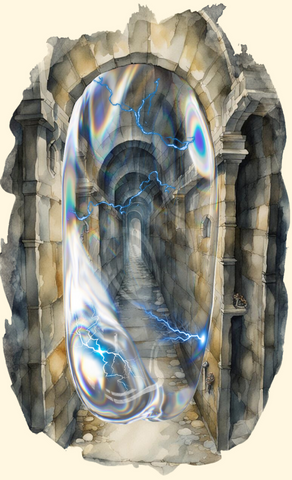
The trap is triggered when someone enters the room without speaking the correct password.
To stop intruders from immediately backtracking, a shimmering barrier of arcane energy spreads wall to wall behind them in the corridor outside.
It slowly moves towards the archway, funnelling stragglers into the room.
Initiative
The trap acts on initiative count 10 and 20, representing its multi-phase nature.
Initiative Count 20:
Energy Surge (Each Round)
When the trap activates, magical energy surges between four crystals positioned in each corner of the room. This effect then radiates to the centre of the room, catching everyone within in their blast wave.
Effect: Each creature in the room must make a DC 15 Dexterity saving throw, taking 4d4 elemental damage on a failed save, or half as much damage on a successful one.

Initiative Count 10:
Arcane Lockdown (Round 1)
In the first round, on initiative 10 a magical barrier seals the room's exits.
Effect: The exits become impassable. Attempting to break through the barrier by force triggers a magical backlash of 2d6 force damage.
Phase Shift (Each Round)
Every round, the trap enters a new phase. On initiative count 10 the crystals change colour, indicating the shift in the elemental nature of the next energy surge.
Effect: The elemental damage produced by the trap alternates between lightning, fire, acid and cold.
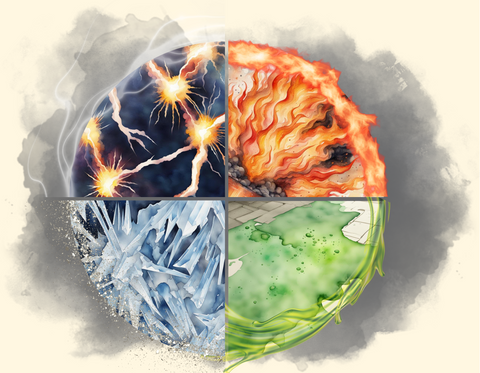
The colour that the crystals change to corresponds to the type of damage that will be done next (red for fire, green for acid, yellow for lightning, blue for cold).
The type of saving throw and damage tha occurs on the next initiative count 20 will change according to the elemental damage done (e.g., Dexterity saves for lightning damage, Constitution saves for cold).
Countermeasures Players might take

There are plenty of different things your players could do to try and get around the trap. I have prepared some ideas and DCs here, but please don’t feel limited to this list!
If your players come up with a creative idea that you think could work then reward them with the chance of success!
Here are some options for how I imagine players might try to mitigate the effects of the trap:
Disabling Crystals
A player can attempt to permanently disable a crystal with a successful DC 18 Thieves' Tools check to carefully remove it from its setting.
Players could also disable crystals by using the spell Dispel Magic, which deactivates the crystal it is cast on.

Crystals can also be destroyed by brute force. They have an armor class of 14 and 25 hit points.
If a crystal is destroyed, it releases a burst of arcane energy in a 5 ft radius sphere around it, doing 3d6 force damage.
No matter what method is used, disabling a crystal reduces the damage caused by the trap by 1d4.
Disarming the Magical Kill Switch
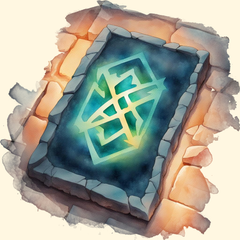
The designer of the trap included a failsafe in the form of a rune hidden in the room that will deactivate all the crystals.
Finding the rune requires a DC 18 Investigation check.
Deactivating the rune requires a DC 18 Arcana check or a spell like Dispel Magic.
Predicting the Phase Shift
After a round or two, players will probably notice the pattern in the trap's phase shifts and how the crystal colour changes relate to changes in damage types.

A DC 15 Intelligence or Insight check will allow them to recognise which colours relate to which elemental energies.
Players can use this knowledge to anticipate and prepare for the next elemental surge.
Ways they can prepare are with spells like Absorb Elements, or anything that could give them resistance.
You might also consider placing a magic item earlier in the dungeon for them to find that absorbs fire or lightning.
Dispelling the Barrier
Characters might want to try and remove the barrier trapping them in a room. They could do this either by disrupting the barrier with a successful DC 20 Arcana check or by using a Dispel Magic spell (4th level or higher).
Running the Trap
So that's how the trap works. Let's look now at how to run it!
Step 1, Players see into the room
Read or paraphrase the following:
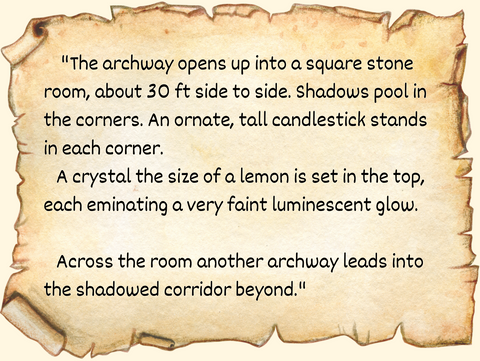
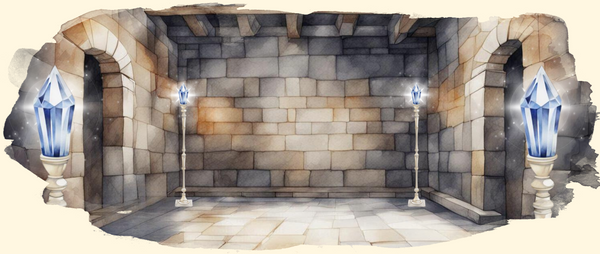
Step 2, a player enters the room without speaking the password.
Read or paraphrase the following:
!["[So-and-so], as you pass under the archway you feel an odd tingle of static in your fingers. There is a faint smell in the air, like burning tin. [Anyone-hanging-back], you begin to sense a faint hum behind you, just on the edge of your hearing . Glancing over your shoulder, you see a shimmering barrier has formed across the corridor behind you, irridescent like the surface of a bubble. You realise with a start that the barrier is moving down the corridor towards you. As it slowly evelops torch bracket on the wall a few arcane sparks flash across the barrier. It creeps forwards another few inches and you watch as the torch bracket crumbles to dust. I need you all to roll initiative!"](https://cdn.shopify.com/s/files/1/0302/6570/4585/files/Interactive_Trap_dnd_5e_trap_d_D_trap_DnD_Traps_DnD_trap_ideas_dungeons_and_dragons_trap_dnd_interactive_trap_original_dnd_complex_trap_dnd_traps_and_puzzles_5_480x480.png?v=1707182632)
If a character is caught by the energy wall they must make a dexterity saving throw, taking 2d6 force damage on a successful save, half as much on a failure, and in either case is violently shunted 10 ft forwards, or into the room.
Step 3, Trap Fully Activates
Round 1 in Initiative Order
Initiative Count 20
When the trap activates, arcs of magical energy surge between four crystals positioned in each corner of the room, then radiate in to the centre.
!["The crystals in the corners of the room begin to glow brighter. [Person-closest-to-crystals], you see electric yellow light seep into the gems. The gem in the North-West corner of the room surges in brightness and an bolt of lightning shoots from that crystal, arcing around the room through the other gems. Electrical energy immediately bursts forth, filling the room. [Everyone in the room], I need you to make a Dexterity saving throw for me."](https://cdn.shopify.com/s/files/1/0302/6570/4585/files/Interactive_Trap_dnd_5e_trap_d_D_trap_DnD_Traps_DnD_trap_ideas_dungeons_and_dragons_trap_dnd_interactive_trap_original_dnd_complex_trap_dnd_traps_and_puzzles_7_480x480.png?v=1709681500)
Each creature in the room must make a DC 15 Dexterity saving throw, taking 4d4 lightning damage on a failed save, or half as much damage on a successful one.
Initiative Count 10
The moving arcane barrier in the corridor reaches the room and the exits become impassable. Crystals turn red, preparing for fire damage next turn.
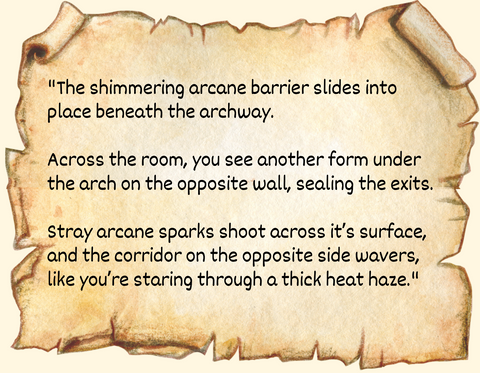
If a character is caught by the energy wall they must make a dexterity saving throw, taking 2d6 force damage on a successful save, half as much on a failure, and in either case is shunted 10 ft forwards, or into the room.
Attempting to break through the barrier by force triggers a magical backlash of 2d6 force damage.

!["[Person-closest-to-crystal], you notice the yellow light fade from the crystals, replaced with an smouldering red glow. The air smells of sulphur and brimstone."](https://cdn.shopify.com/s/files/1/0302/6570/4585/files/Interactive_Trap_dnd_5e_trap_d_D_trap_DnD_Traps_DnD_trap_ideas_dungeons_and_dragons_trap_dnd_interactive_trap_original_dnd_complex_trap_dnd_traps_and_puzzles_10_480x480.png?v=1709682961)
Round 2 in Initiative Order
Initiative Count 20
The trap activates again. This time arcs of magical fire shoot between four crystals and radiates through the room.
!["The red glow filling the crystals flares white hot. The gem in the North-East corner of the room emits a jet of flame that burns a fiery path around the room into the other crystals, exploding into the room. [Everyone in the room], I need you to make a Dexterity saving throw for me."](https://cdn.shopify.com/s/files/1/0302/6570/4585/files/Interactive_Trap_dnd_5e_trap_d_D_trap_DnD_Traps_DnD_trap_ideas_dungeons_and_dragons_trap_dnd_interactive_trap_original_dnd_complex_trap_dnd_traps_and_puzzles_11_480x480.png?v=1709683198)
Each creature in the room must make a DC 15 Dexterity saving throw, taking 4d4 (unless any crystals have been deactivated) fire damage on a failed save, or half as much damage on a successful one.
Initiative Count 10
Crystals turn green, preparing for acid damage next turn.

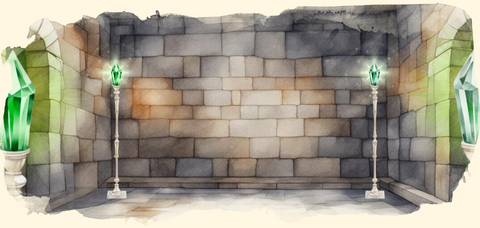
The Rest of Playthrough
Ok, I won’t write out every round, I’ll leave that to you!
In Round 3, the South-East Gem will activate the trap next, causing acid damage. The crystals will then glow blue.
In Round 4, the South-West Crystal will activate, causing cold damage. Note, this will be a constitution save rather than a dexterity save.

If players deactivate any crystals, then they will not be included in the active stage of the trap in subsequent rounds. Reduce the elemental damage by 1d4 for each crystal that is deactivated.
Adjustments for Lower Level Parties (Levels 3-7)
Reduce the Damage

Start the trap with one of the crystals already broken. This will reduce the damage to 3d4 per round, and will hopefully give your players a stronger hint that damaging the crystals will make them ineffective.
For parties on the lower end of the scale I would also reduce the force damage from the barrier to 2d6.
Lower the DCs
Adjust the saving throw DC to 12-13 and the DCs for disabling mechanisms to 14-16.
Change the phase effects:

For really low level parties I would suggest changing some of the damage phase effects to something that imposes a condition. For example, you might change the acid damage to the poison condition, or the cold damage to slowed movement.
To make the trap more suitable to higher level parties I'd suggest pretty much doing the complete opposite.
The Final Takeaway
So there we have it! A fun little trap to pop into your DnD games ^ ^
It’s complex, but not too complicated, with some moving parts and changes each round to keep your players on their toes.
Feel free to drag and drop it into any of your roleplaying games and please let me know how you find it!
Enjoy!
